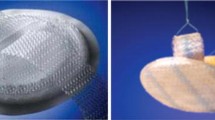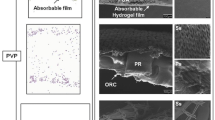Abstract
Background
Placement of an intraperitoneal prosthetic is required for laparoscopic ventral hernia repair. The biocompatibility of these prosthetics determines the host’s inflammatory response, scar plate formation, tissue ingrowth, and subsequent mesh performance, including prosthetic compliance and prevention of hernia recurrence. We evaluated the host response to intraperitoneal placement of several prosthetics currently used in clinical practice.
Methods
A 4-cm × 4-cm piece of mesh was implanted on intact peritoneum in New Zealand white rabbits. The mesh types included expanded polytetrafluoroethylene (ePTFE) (DualMesh®), ePTFE and polypropylene (Composix®, heavyweight polypropylene), polypropylene and oxidized regenerated cellulose (Proceed®, midweight polypropylene), and polypropylene (Marlex®, heavyweight polypropylene). At four months, standard hematoxylin and eosin and Milligan’s trichrome stains of the mesh-tissue interaction were analyzed by three observers blinded to the mesh types. Each specimen was evaluated for scar plate formation, inflammatory response, and tissue ingrowth. Each of these three categories was graded on a standard scale of 1–4 (1 = normal tissue and 4 = severe inflammatory response). The scores were analyzed using Wilcoxon rank sum test with p < 0.05 as significant.
Results
Ten samples of each mesh type were evaluated. There was no difference in tissue incorporation between the groups. The mean scar plate formation was greater in the heavyweight polypropylene meshes than for DualMesh (p = 0.04). With Proceed, the reduction in scar plate formation compared with that for Composix and Marlex approached statistical significance (p = 0.07). The mean number of inflammatory cells was greater around the ePTFE when compared with the midweight polypropylene (p = 0.02) but equal to the other meshes.
Conclusions
The four prosthetic materials evaluated in this study demonstrate comparable host biocompatibility as evidenced by the tissue ingrowth. Scar plate formation around DualMesh was significantly less than that around Composix and Marlex. Interestingly, more inflammatory cells were noted surrounding the DualMesh which was equal to that of the heavyweight meshes. Proceed, a midweight polypropylene mesh, has the potential for improved patient tolerance compared to heavyweight polypropylene meshes based on its favorable histologic findings.


Similar content being viewed by others
References
Amid PK (1997) Classification of biomaterials and their related complications in abdominal wall hernia surgery. Hernia 1: 15–21
Burger JW, Luijendijk RW, Hop WC, Halm JA, Verdaasdonk EG, Jeekel J (2004) Long-term follow-up of a randomized controlled trial of suture versus mesh repair of incisional hernia. Ann Surg 240: 578–583; discussion 583–575
Cobb WS, Kercher KW, Heniford BT (2005) The argument for lightweight polypropylene mesh in hernia repair. Surg Innov 12: 63–69
Cumberland VH (1952) A preliminary report on the use of prefabricated nylon weave in the repair of ventral hernia. Med J Aust 1: 143–144
Harrell AG, Novitsky YW, Cobb WS, Austin CE, Cristiano JA, Kercher KW, Heniford BT (2006) Prospective evaluation of adhesion formation and shrinkage of intra-abdominal prosthetics in a rabbit model. Am Surg 72: 808–813
Heniford BT, Park A, Ramshaw BJ, Voeller G (2000) Laparoscopic ventral and incisional hernia repair in 407 patients. J Am Coll Surg 190: 645–650
Heniford BT, Park A, Ramshaw BJ, Voeller G (2003) Laparoscopic repair of ventral hernias: nine years’ experience with 850 consecutive hernias. Ann Surg 238: 391–399; discussion 399–400
Institute of Laboratory Animal Resources (U.S.) (1996) Guide for the care and use of laboratory animals. National Academy Press, Washington, DC
Klinge U, Klosterhalfen B, Conze J, Limberg W, Obolenski B, Ottinger AP, Schumpelick V (1998) Modified mesh for hernia repair that is adapted to the physiology of the abdominal wall. Eur J Surg 164: 951–960
Klinge U, Klosterhalfen B, Muller M, Ottinger AP, Schumpelick V (1998) Shrinking of polypropylene mesh in vivo: an experimental study in dogs. Eur J Surg 164: 965–969
Klinge U, Klosterhalfen B, Muller M, Schumpelick V (1999) Foreign body reaction to meshes used for the repair of abdominal wall hernias. Eur J Surg 165: 665–673
Junge K, Klinge U, Rosch R, Klosterhalfen B, Schumpelick V (2002) Functional and morphological evaluation of a low-weight, monofilament polypropylene mesh for hernia repair. J Biomed Mater Res 63: 129–136
Klosterhalfen B, Junge K, Klinge U (2005) The lightweight and large porous mesh concept for hernia repair. Expert Rev Med Devices 2: 103–117
Leber GE, Garb JL, Alexander AI, Reed WP (1998) Long-term complications associated with prosthetic repair of incisional hernias. Arch Surg 133: 378–382
Luijendijk RW, Hop WC, van den Tol MP, de Lange DC, Braaksma MM, IJzermans JN, Boelhouwer RU, de Vries BC, Salu MK, Wereldsma JC, Bruijninckx CM, Jeekel J (2000) A comparison of suture repair with mesh repair for incisional hernia. N Engl J Med 343: 392–398
Matthews BD, Pratt BL, Backus CL, Kercher KW, Heniford BT (2002) Comparison of adhesion formation to intra-abdominal mesh after laparoscopic adhesiolysis in the New Zealand White rabbit. Am Surg 68: 936–940; discussion 941
Matthews BD, Pratt BL, Pollinger HS, Backus CL, Kercher KW, Sing RF, Heniford BT (2003) Assessment of adhesion formation to intra-abdominal polypropylene mesh and polytetrafluoroethylene mesh. J Surg Res 114: 126–132
Matthews BD, Mostafa G, Carbonell AM, Joels CS, Kercher KW, Austin C, Norton HJ, Heniford BT (2005) Evaluation of adhesion formation and host tissue response to intra-abdominal polytetrafluoroethylene mesh and composite prosthetic mesh. J Surg Res 123: 227–234
Mudge M, Hughes LE (1985) Incisional hernia: a 10 year prospective study of incidence and attitudes. Br J Surg 72: 70–71
Novitsky YW, Harrell AG, Paton BL, Zerey M, Cristiano JA, Kercher KW, Heniford BT (2006) Comparative evaluation of adhesion formation, strength of ingrowth, and textile properties of various prosthetic biomaterials one-year after intra-abdominal implantation in a rabbit. J Surg Res 136(1):1–7
Park A, Birch DW, Lovrics P (1998) Laparoscopic and open incisional hernia repair: a comparison study. Surgery 124: 816–821; discussion 821–812
Scales JT (1953) Tissue reactions to synthetic materials. Proc R Soc Med 46: 647–652
Voskerician G, Gingras PH, Anderson JM (2006) Macroporous condensed poly(tetrafluoroethylene). I. In vivo inflammatory response and healing characteristics. J Biomed Mater Res A 76:234–242
Welty G, Klinge U, Klosterhalfen B, Kasperk R, Schumpelick V (2001) Functional impairment and complaints following incisional hernia repair with different polypropylene meshes. Hernia 5: 142–147
Author information
Authors and Affiliations
Corresponding author
Additional information
Presented at the SAGES Annual Scientific Meeting, Dallas, Texas, 26–29 April 2006
Study sponsored in part by Ethicon, Inc., Somerville, NJ
Rights and permissions
About this article
Cite this article
Harrell, A.G., Novitsky, Y.W., Cristiano, J.A. et al. Prospective histologic evaluation of intra-abdominal prosthetics four months after implantation in a rabbit model. Surg Endosc 21, 1170–1174 (2007). https://doi.org/10.1007/s00464-006-9147-y
Received:
Accepted:
Published:
Issue Date:
DOI: https://doi.org/10.1007/s00464-006-9147-y




